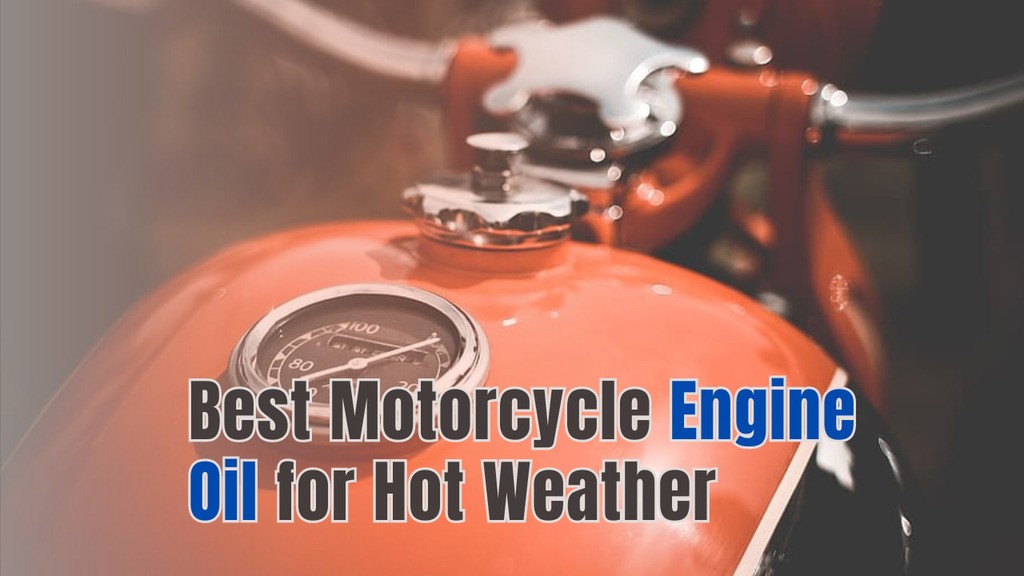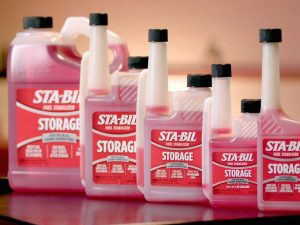Summer heat doesn’t just make your ride uncomfortable, it can also punish your motorcycle’s engine. Regular oil thins out in extreme temperatures, reducing its ability to lubricate and protect vital components. To keep the bike’s engine temps normal, you need the best oil for very hot temperatures. But with so many options, choosing the right one can be tricky.
This roundup reviews the top contenders for best motorcycle engine oil in hot weather. We’ll explore semi- and fully synthetic oil, viscosity grades, and features that make these options the best motor oil for summer rides.
Some of the links in this post are affiliate links, meaning we may get a small commission when you purchase through our links, at no extra cost to you. It helps us covering the expenses of keeping this site free for you. Thank you for your support!
Best Motorcycle Engine Oil for Hot Weather: 5 Options
When the temperatures go up, a bike’s engine suffer a lot. But not all oils are created equal in to endure the rising temperature.
This guide shortlists the best options for high-temperature protection. Find the formula to keep your motor smoothly riding while staying cool under pressure.
1
BEST PERFORMANCE FOR LIQUID-COOLED BIKE
Motul 7100 4T Synthetic Ester Motor Oil – 10W60

🎯What We Love
- Smoother engine operation
- Improved response during acceleration
- Thermal stability protects against heat
- Extended service life saves money
⛔Things To Consider
- Higher price point than conventional oil
- Potential incompatibility with some air-cooled engines
- Works best with liquid cooling
As one who’s logged many miles under the blazing sun, I’m always on the lookout for top-tier engine oils that make hot weather riding more enjoyable. After putting Motul’s 7100 4T Synthetic Ester Oil to the test, I can assure you it’s a champion in the heat.
I’ve been running conventional dino oil in my old Guzzi V7 Classic for years without issue. But my buddy convinced me to try this one before our big Mojave tour, and wow—what a difference. Where before the V-twin would get a bit buzzy past 5k RPM, now it pulls as smooth as glass all the way to the rev limiter. With its unique formulation, the 7100 just tames vibration better than anything I’ve used.
SEE MORE: How Much Engine Oil Is Too Much for a Motorcycle
And does it ever hold up in the heat! Where other oils start breaking down, this Motul just laughs in the face of triple digit temperatures. My Guzzi’s gearbox has never shifted so cleanly, even tackling long mountain grades in Death Valley. The catalytic converter thankfully remains unclogged too. Best of all, at 4,000 mile changes I’m saving a tank of gas each season—and my wallet appreciates that.
I won’t claim it’s perfect for every ride. On really air cooled engines without liquid circulation, you may see higher consumption. But for anything with coolant, I wholeheartedly recommend giving the 7100 a try. The performance is well worth the slight premium over basic oils in my book. Just do your research first if you’ve got an older cruiser.
Key Features at a Glance:
- Ester synthetic base for excellent protection in heat
- Extreme pressure formula guards transmission
- Low sulfur conserves catalytic converters
- Stays slick for long drain intervals
2
AFFORDABLE PROTECTION FOR HOT WEATHER
Maxima Racing Oils Pro Plus+ 10W-50 Synthetic

🎯What We Love
- Maintains viscosity better than other synthetics
- Affordable for quality protection
- Quieted noise and increased throttle response
- Allows engines to run cooler in hot ambient temperature
⛔Things To Consider
- Opaque bottle not ideal for filling levels
- Not a suitable oil for casual riding
- Limited retail availability vs online
I’ve tried many oil types out there to keep the bike running smooth in summer. There’ve been a few disappointments over the years that leave a sour taste, but also some true gems that earn a permanent spot in my garage. Maxima’s Pro Plus+ falls firmly in the latter category.
I remember the day I switched – it was 112 degrees in Death Valley and my previous oil was breaking down faster than a politician’s promise. The bike was getting hotter by the mile and I was worried I wouldn’t make it out before an overheat.
One fill-up later and those concerns were gone. This ester-loaded formula stays fluid when others start to fade, ensuring cooling passages flow freely to keep temps in the reasonable range even in hellish conditions.
The oil will act as a lubricant for shifting and clutching, making them super smooth on a hot day as a cool one, which is no mean feat for an oil, let alone one that maintains protection for so long. My buddies swear it even smooths out valve tap under hard acceleration. Best of all, the value is unbeatable. For the premium protection you get mile after mile, it’s a real bargain.
Key Features at a Glance:
- Ester-fortified formula for high heat protection
- Superior lubricity for smooth shifting/clutching
- Keeps engines clean for long-term durability
- Exceeds demand standards for race applications
3
BEST FOR V-TWIN ENGINES
Mobil 1 20W-50 V-Twin Synthetic Oil

🎯What We Love
- Excellent high temp stability and durability
- Available anywhere for top-ups on the go
- Revitalized performance in older bikes
- Met or exceeded all manufacturers’ specs
⛔Things To Consider
- Expensive per bottle compared to other synthetics
- Thicker 20W-50 weight cold start issues for some
- Specialized for V-twins over other engine designs
In the heat of summer, your bike needs all the protection it can get. That’s where this Mobil 1 20W-50 V-Twin oil comes in.
It makes old motorcycles run smoother – no more clatter or noise. Shifting was like butter, whether in city traffic or out on the highway. Even my buddy’s worn-out Suzuki got new life with this stuff.
Of course, nothing’s perfect. It can cause rough starts below 50 degrees, since 20W-50 is on the thicker side. We all know our twins run a bit warmer, so 15W40 may do better on those chilly mornings. But most days, you can’t beat this for warm weather riding.
SEE MORE: Say Goodbye to Carburetor Gunk with Carb Cleaners for Motorcycles
The real selling point though? Durability. Mobil 1 has served riders faithfully for decades, and this formula is no different. It protects without compromise, meeting all the makers’ standards. Classic and high-mileage bikes especially thrive on it.
It may cost a bit extra compared to similar brands. But when you consider the trust pros have in this brand, the peace of mind is worth it. I sleep easy knowing my engine’s protected, no matter the conditions. And the convenience of finding it anywhere? Priceless when you’re on the road.
Key Features at a Glance:
- Specialized additive package for V-twin engines
- Wide operating temperature range protection
- Eliminates noise and clatter from wear
- Smoothest shifts of any oil tested
4
BEST VALUE FOR ENGINE WEAR PROTECTION
Lucas Oil LUC10710 10W-40 Semi-Synthetic Motorcycle Oil

🎯What We Love
- Smoother shifting and reduced clutch wear
- Exceptional value for money
- Met all industry specifications
- Easy to experiment with additional additives
⛔Things To Consider
- Varied performance on some motorcycle designs
- Not ideally suited for all engine types
- Potential incompatibility with some clutches
Lucas Oil’s 10W-40 just might be my new go-to oil for the hot summer months. You wouldn’t think a semi-synthetic could handle the blistering heat in Arizona or California, but this stuff has really impressed me over the past few seasons.
I have an old Honda. It started making loud knocking sound a few years ago. The valves get ticked off at me for riding them so hard in 100+ degree weather. But switching to Lucas really calmed things down under the hood.
SEE MORE: Best Hot Weather Motorcycle Jacket for Blistering Summer Rides
The clutch feels as smooth as they come too, even with how much abuse I give it shifting through the gears. No more grabbing or hesitation on downshifts, it just slides in and out like butter on a hot pan. Clutch life seems to have doubled since making the switch as well.
Now I’ll admit, it ain’t perfection for every bike out there. My cousin Ray had some slippage issues in his DongFang, but those Chinese clones have always been a bit finicky if you ask me. For a reliable Japanese bike though, this Lucas stuff has been a dream. Best part is, it doesn’t cost much and more mileage means you can save on future oil changes.
Key Features at a Glance:
- Exclusive additives for clutch cushioning
- Extended drain intervals and lower consumption
- Withstands high heat for protection
- Revitalized older high-mileage engines
5
RELIABLE YAMAHA ENGINE OIL
Yamalube All Purpose 4 Four Stroke Oil 10w-40

🎯What We Love
- OEM recommended for best performance
- Exceptional value for money
- Long drain intervals save on changes
- Compatible with all Yamaha engines
⛔Things To Consider
- Not suited for non-Yamaha bikes
- Could be visually boring to some
- Limited availability vs. global brands
- Not advertised widely for new buyers
After putting miles upon miles across this great country on my Yamaha, one thing I’ve learned is Yankee reliability ain’t cheap, and cheap ain’t reliable. But I can trust Yamalube in this case.
The name may sound underwhelming because of no flashy ads or extreme claims of turning sand into gold. But this stuff works. My old bike’s eaten up over 100,000 miles of Arizona asphalt, Nevada salt flats and Texas tail of the dragon, and it still runs smoothly.
Yamalube’s special OEM formula is engineered just for our Yams, keeping everything operating in harmony even in 100 degrees heat. It’s what keeps my clutch plates gliding through the Grand Canyon without a fuss.
And talk about value. The oil lasts so long between changes that you can save a lot. In my book, and in my Yamaha, Yamalube’s the real Motorcycle MVP.
Key Features at a Glance:
- Formulated specifically for Yamaha engines
- Provides smooth power and quiet operation
- Resolves clutch slippage issues in some bikes
- Proven high-mileage protection
Which Is the Best Oil to Use in Summer Rides?
Choosing the best engine oil for a better experience during summer rides is an important decision for any motorcycle owner.
We’ve examined the pros and cons of conventional, synthetic blend, and full synthetic oils to help determine which oil would provide the best protection for engine components when temperatures soar.
Synthetic or Synthetic Blend Oil
It’s the best oil available to keep the engine and cooling system in an operating temp when the weather is hot.
One of the main reasons is that this oil comes from natural gas rather than refined crude oil. As a result, its molecules can withstand high temperatures better than other oil types.
The blend version takes the thinner parts of the oil from synthetic sources and combines them with thicker parts refined from crude oil. This still provides an improved molecule over conventional oil.
Another advantage is the additive package – premium synthetic types contain powerful chemicals that allow the oil to work better at protecting the engine.
Avoid Thinner Oil for Older Engines
While some suggestions recommend thinner grade oil for older, higher mileage engines, thicker oil actually makes more sense the more the engine has been used.
As an engine ages and tolerances increase, thicker oil will provide better lubrication and wear protection. Stick with the manufacturer’s recommended viscosity grade for your climate conditions.
For example, some owners may choose a 20W50 oil weight in high temperatures instead of the usual 10W40. Just be sure not to use “energy conserving” oils meant for cars, as these can cause issues with motorcycle wet clutch systems.
Give Synthetic Oil Time to Work
It’s an expensive oil and can take a few thousand miles for the benefits to really be noticeable as residual conventional oil is flushed out.
Switching to the synth type from conventional oil may not instantly result in smoother shifts or quieter operation. Over longer use, it’ll provides better gas mileage, lower operating temperatures, and reduced engine wear compared to conventional oil.
FAQs About the Best Motorcycle Engine Oil for Hot Weather
How does heat affect engine oil?
High temperatures can cause conventional oils to break down faster, reducing their lubricating ability. Oil thickness also thinning in heat leads to less protection.
Should I switch to a heavier weight oil in summer?
Many modern synthetics can maintain performance across a wide range, but some engines may benefit from going up 5-10 points, like 10W-40 to 15W-50, for better high-temp stability.
Are synthetic oils really worth it for summer riding?
Yes, their special molecules resist breakdown from heat better. Plus, synthetics provide better film strength and work as friction modifiers at any temperature. Brand matters too for additive packages.
When should I change to a summer-rated oil?
Once sustained outside temps hit 90°F is a good guideline. But riding style and your climate also factor in. It’s safe to switch with the seasons.
Can using the wrong oil harm my engine?
Definitely. An oil that thins or breaks down prematurely loses its lubricating abilities. This increases wear on critical parts and heat buildup, potentially causing damage over time if unaddressed.
How can I tell if my motorcycle oil is degrading?
Check your oil frequently in summer. Look for changes in color, smell burnt odors, and feel for thicker consistency as it breaks down. Catching and addressing problems early saves your engine.




